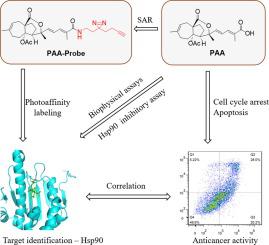Bioorganic Chemistry ( IF 4.5 ) Pub Date : 2021-05-05 , DOI: 10.1016/j.bioorg.2021.104963 Jiangxin Liu 1 , Xing-De Wu 1 , Wenyan Li 1 , Zaifeng Yuan 1 , Kun Yang 1 , Qin-Shi Zhao 1

|
Pseudolaric acid A (PAA), one of the main bioactive ingredients in traditional medicine Pseudolarix cortex, exhibits remarkable anticancer activities. Yet its mechanism of action and molecular target have not been investigated and remain unclear. In this work, mechanistic study showed that PAA induced cell cycle arrest at G2/M phase and promoted cell death through caspase-8/caspase-3 pathway, demonstrating potent antiproliferation and anticancer activities. PAA was discovered to be a new Hsp90 inhibitor and multiple biophysical experiments confirmed that PAA directly bind to Hsp90. Active PAA-probe was designed, synthesized and biological evaluated. It was subsequently employed to verify the cellular interaction with Hsp90 in HeLa cells through photoaffinity labeling approach. Furthermore, NMR experiments showed that N-terminal domain of Hsp90 and essential groups in PAA are important for the protein-inhibitor recognition. Structure-activity relationship studies revealed the correlation between its Hsp90 inhibitory activity with anticancer activity. This work proposed a potential mechanism involved with the anticancer activity of PAA and will improve the appreciation of PAA as a potential cancer therapy candidate.
中文翻译:

假落叶酸A作为一种新的Hsp90抑制剂的发现揭示了其潜在的抗癌机制
Pseudolaric acid A (PAA),传统医药中的主要生物活性成分之一Pseudolarix cortex, 表现出显着的抗癌活性。然而,其作用机制和分子靶点尚未得到研究,仍不清楚。在这项工作中,机理研究表明,PAA 诱导细胞周期停滞在 G2/M 期,并通过 caspase-8/caspase-3 途径促进细胞死亡,显示出有效的抗增殖和抗癌活性。PAA 被发现是一种新的 Hsp90 抑制剂,多项生物物理实验证实 PAA 直接与 Hsp90 结合。活性 PAA 探针被设计、合成和生物学评估。随后它被用来通过光亲和标记方法验证 HeLa 细胞中与 Hsp90 的细胞相互作用。此外,核磁共振实验表明,NHsp90 的末端结构域和 PAA 中的必需基团对于蛋白质抑制剂识别很重要。构效关系研究揭示了其 Hsp90 抑制活性与抗癌活性之间的相关性。这项工作提出了一种与 PAA 抗癌活性有关的潜在机制,并将提高对 PAA 作为潜在癌症治疗候选药物的认识。






























 京公网安备 11010802027423号
京公网安备 11010802027423号